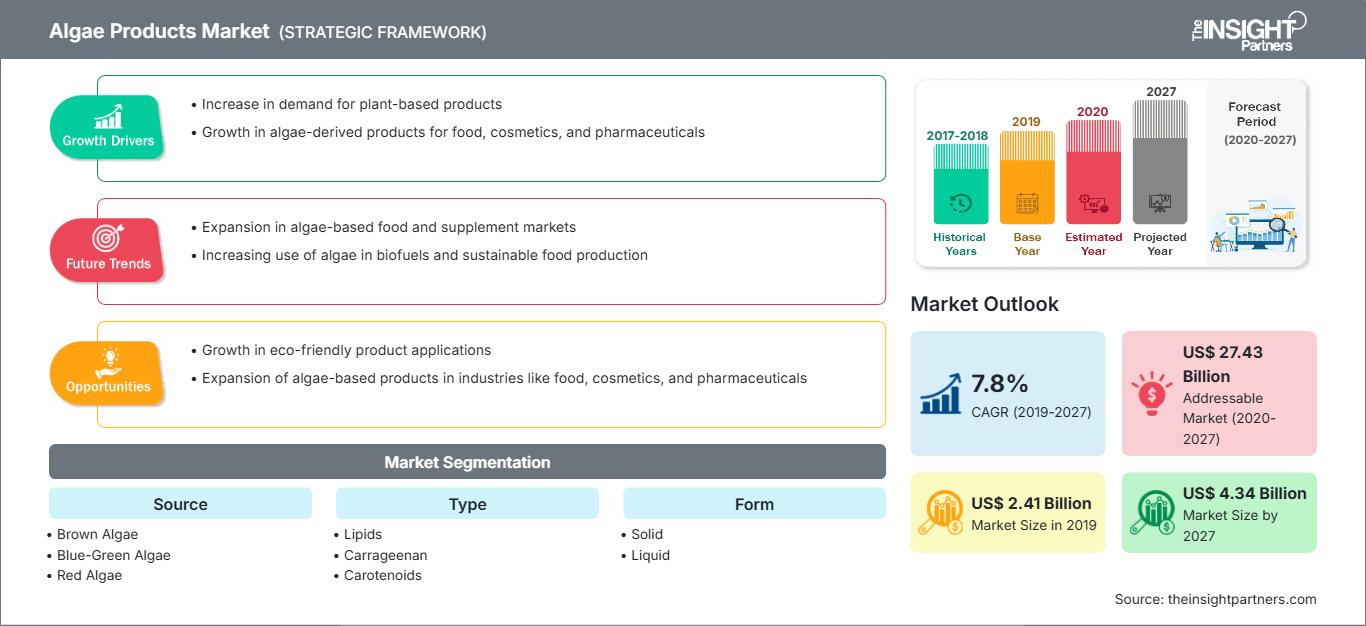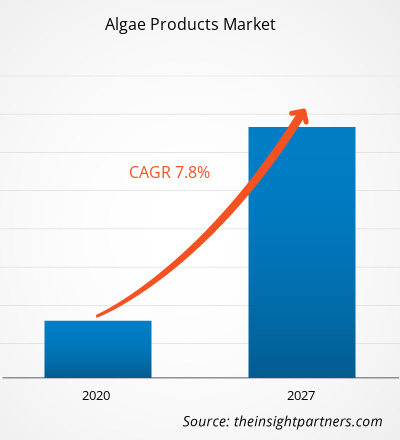[Forschungsbericht]Der Markt für Algenprodukte wurde 2019 auf 2.405,5 Millionen US-Dollar geschätzt und soll bis 2027 4.339,3 Millionen US-Dollar erreichen; von 2020 bis 2027 wird ein durchschnittliches jährliches Wachstum von 7,8 % erwartet.
Algen entwickeln sich aufgrund ihrer zahlreichen Vorteile und der einfachen Produktion zu einer der vielversprechendsten langfristigen und nachhaltigen Quellen für Kraftstoffe, Nahrungsmittel, Futtermittel und andere Nebenprodukte von Biomasse und Ölen. Algen haben sich im Laufe von einer Milliarde Jahren so entwickelt, dass sie Energie effizient produzieren und speichern können, wie kein anderer bekannter natürlicher oder künstlicher Prozess. Darüber hinaus können Mikroalgen mit einem hohen Protein- und Ölgehalt gezüchtet werden, um entweder Biokraftstoffe oder Tierfutter oder beides zu produzieren. Darüber hinaus wird die an Mikronährstoffen reiche Mikroalgenbiomasse bereits für Nahrungsergänzungsmittel zur Verbesserung der menschlichen Gesundheit verwendet. Die wichtigste Anwendung im Lebensmittelmarkt ist die Verwendung von Mikroalgenbiomasse als Nahrungsergänzungsmittel. Mikroalgen dienen auch als Quelle für Lebensmittelzutaten, darunter Carotinoide und Omega-3-Fettsäuren. Ebenso wird Agar als Gelatineersatz in der Lebensmittelindustrie verwendet und kommt bei der Herstellung von Cremes, Soßen, Mayonnaise, Gelees, Vanillesoßen, Puddings, Schmelzkäse und tiefgekühlten Milchprodukten zum Einsatz. Es wird auch in Marmeladen und Konfitüren zum Gelieren und Andicken sowie als Anti-Trockenmittel in Brot und Gebäck verwendet. Darüber hinaus dient Agar als Verdickungsmittel in Eiscreme und anderen Desserts. Somit dienen Algenprodukte als alternative Nahrungsquelle und Lebensmittelzutat und treiben das Marktwachstum für Algenprodukte voran.
Nordamerika hatte 2019 den größten Marktanteil. Darüber hinaus wird für den asiatisch-pazifischen Raum im Prognosezeitraum 2020–2027 ein lukratives Wachstum prognostiziert. In den USA und anderen Teilen der Welt werden Algen häufig als Nahrungsergänzungsmittel verwendet. Sie stärken das Immunsystem, reparieren Nervengewebe, normalisieren den Blutzuckerspiegel und versorgen den Körper mit zusätzlichen Proteinen und Ballaststoffen. In China und Japan werden Algen seit über 4.000 Jahren als Nahrungsmittel für den Menschen geerntet.
Passen Sie diesen Bericht Ihren Anforderungen an
Sie erhalten kostenlos Anpassungen an jedem Bericht, einschließlich Teilen dieses Berichts oder einer Analyse auf Länderebene, eines Excel-Datenpakets sowie tolle Angebote und Rabatte für Start-ups und Universitäten.
Markt für Algenprodukte: Strategische Einblicke

-
Holen Sie sich die wichtigsten Markttrends aus diesem Bericht.Dieses KOSTENLOSE Beispiel umfasst Datenanalysen, die von Markttrends bis hin zu Schätzungen und Prognosen reichen.
Die USA haben im Vergleich zu Kanada und Mexiko die höchste Zahl bestätigter Coronavirus-Fälle. Die COVID-19-Pandemie erzwingt weiterhin die vorübergehende Schließung von Einzelhandelsgeschäften und Produktionsstätten in den Ländern Nordamerikas und signalisiert damit eine beispiellose Störung des Handels. Einzelhändler und Marken stehen vor verschiedenen kurzfristigen Herausforderungen in Bezug auf Gesundheit und Sicherheit, Lieferkette, Arbeitskräfte, Cashflow, Verbrauchernachfrage und Marketing. In Nordamerika begannen Anfang März Geschäfte zu schließen, und dieser Trend dürfte sich fortsetzen, da Städte und Bundesstaaten darum kämpfen, die Ausbreitung des Virus einzudämmen. Darüber hinaus beschleunigt die COVID-19-Pandemie die Tradition des digitalen Handels rapide. Da den Menschen geraten wird, soziale Distanz zu wahren, sind E-Commerce-Bestellungen von Medikamenten sowie lebenswichtigen Lebensmitteln und Getränken zu einem Überlebensinstrument für die Menschen in Nordamerika geworden.
Markteinblicke: Exponentielles Wachstum im Biokraftstoffmarkt
In den letzten zehn Jahren hatte die Algenindustrie Mühe, den Biokraftstoffmarkt aufrechtzuerhalten. Das Produkt hat jedoch das Potenzial, enormes Potenzial zu entfalten, sobald die Hersteller die kritischen Hürden in Bezug auf Rohstoffherstellung, Kapitalkosten und Produktionsvolumen überwunden haben. Die weltweite Einführung von Biokraftstoffvorschriften dürfte die Hersteller im Prognosezeitraum dazu zwingen, mehr in Forschung und Entwicklung zu investieren, um nachhaltige Technologien für die Algenkraftstoffproduktion zu entwickeln. Darüber hinaus gelten Biokraftstoffe als eine der vielversprechendsten potenziellen Quellen erneuerbarer Energie zur Bewältigung der globalen Energiekrise und der Umweltprobleme. Mikroalgenbiomasse hat ihr Potenzial für die Verarbeitung von Biokraftstoffen, Chemikalien und biobasierten Gütern unter Beweis gestellt und trägt so zum Übergang von einer erdölbasierten zu einer biobasierten Wirtschaft bei. Algenbiokraftstoff bietet Vorteile wie ein höheres Wachstum ohne Nahrungsmittelkonkurrenz und minimale oder keine Umweltbelastung. Aus Mikroalgen hergestellter Biokraftstoff hat im Vergleich zu Zellulose-Biokraftstoff mit hohem Brennwert eine niedrige Viskosität und Dichte, wodurch Algen-Biokraftstoff für diese Anwendung besser geeignet ist.
Markteinblicke nach Quellen
Der Markt für Algenprodukte ist nach Quellen in Braunalgen, Blaualgen, Rotalgen, Grünalgen und andere unterteilt. Das Segment Braunalgen war 2019 führend auf dem Markt für Algenprodukte.
Markteinblicke nach Typen
Der Markt für Algenprodukte ist nach Typen in Lipide, Carrageen, Carotinoide, Alginat, Algenprotein und andere unterteilt. Das Segment Carotinoide war 2019 führend auf dem Markt für Algenprodukte.
Markteinblicke nach Formen
Der Markt für Algenprodukte ist nach Formen in fest und flüssig unterteilt. Das Segment der festen Produkte führte den Markt für Algenprodukte im Jahr 2019 an.
Anwendungsbasierte Markteinblicke
Der Markt für Algenprodukte ist je nach Anwendung in Lebensmittel und Getränke, Nutraceuticals und Nahrungsergänzungsmittel, Körperpflegeprodukte, Futtermittel, Pharmazeutika und Sonstiges unterteilt. Das Segment Nutraceuticals & Nahrungsergänzungsmittel führte den Markt für Algenprodukte im Jahr 2019 an.
Organische Wachstumsstrategien sind die von Unternehmen häufig verfolgten Strategien zur Ausweitung ihrer Marktreichweite. Cyanotech Corporation, DSM und Algatech Ltd gehören zu den Marktteilnehmern, die diese Strategie umsetzen, um den Kundenstamm zu vergrößern und weltweit bedeutende Marktanteile zu gewinnen, was ihnen wiederum ermöglicht, ihren Markennamen auf dem globalen Markt für Algenprodukte zu behaupten.
Algenprodukte
Regionale Einblicke in den Markt für AlgenprodukteDie Analysten von The Insight Partners haben die regionalen Trends und Faktoren, die den Markt für Algenprodukte im Prognosezeitraum beeinflussen, ausführlich erläutert. In diesem Abschnitt werden auch die Marktsegmente und die geografische Lage in Nordamerika, Europa, Asien-Pazifik, dem Nahen Osten und Afrika sowie Süd- und Mittelamerika erörtert.
Umfang des Marktberichts zu Algenprodukten
| Berichtsattribut | Einzelheiten |
|---|---|
| Marktgröße in 2019 | US$ 2.41 Billion |
| Marktgröße nach 2027 | US$ 4.34 Billion |
| Globale CAGR (2019 - 2027) | 7.8% |
| Historische Daten | 2017-2018 |
| Prognosezeitraum | 2020-2027 |
| Abgedeckte Segmente |
By Quelle
|
| Abgedeckte Regionen und Länder |
Nordamerika
|
| Marktführer und wichtige Unternehmensprofile |
|
Dichte der Marktteilnehmer für Algenprodukte: Verständnis ihrer Auswirkungen auf die Geschäftsdynamik
Der Markt für Algenprodukte wächst rasant. Die steigende Nachfrage der Endverbraucher ist auf Faktoren wie veränderte Verbraucherpräferenzen, technologische Fortschritte und ein stärkeres Bewusstsein für die Produktvorteile zurückzuführen. Mit der steigenden Nachfrage erweitern Unternehmen ihr Angebot, entwickeln Innovationen, um den Bedürfnissen der Verbraucher gerecht zu werden, und nutzen neue Trends, was das Marktwachstum weiter ankurbelt.

- Holen Sie sich die Markt für Algenprodukte Übersicht der wichtigsten Akteure
- Braunalgen
- Blaualgen
- Rotalgen
- Grünalgen
- Sonstige
Markt für Algenprodukte – nach Typ
- Lipide
- Carrageen
- Carotinoide
- Alginat
- Algenprotein
- Sonstige
Markt für Algenprodukte – nach Form
- Fest
- Flüssig
Markt für Algenprodukte – nach Anwendung
- Lebensmittel und Getränke
- Nutraceuticals und Nahrungsergänzungsmittel
- Körperpflege Produkte
- Futtermittel
- Pharmazeutika
- Sonstige
Firmenprofile
- Algatechnologies Ltd
- Algenol
- BASF SE
- Cargill Incorporated.
- Cellana Inc.
- Corbion nv
- CP Kelco (JM Huber- Corporation
- Cyanotech Corporation.
- DSM Nutritional Products AG
- EID Parry Limited
- Historische Analyse (2 Jahre), Basisjahr, Prognose (7 Jahre) mit CAGR
- PEST- und SWOT-Analyse
- Marktgröße Wert/Volumen – Global, Regional, Land
- Branchen- und Wettbewerbslandschaft
- Excel-Datensatz
Aktuelle Berichte
Erfahrungsberichte
Grund zum Kauf
- Fundierte Entscheidungsfindung
- Marktdynamik verstehen
- Wettbewerbsanalyse
- Kundeneinblicke
- Marktprognosen
- Risikominimierung
- Strategische Planung
- Investitionsbegründung
- Identifizierung neuer Märkte
- Verbesserung von Marketingstrategien
- Steigerung der Betriebseffizienz
- Anpassung an regulatorische Trends






















 Kostenlose Probe anfordern für - Markt für Algenprodukte
Kostenlose Probe anfordern für - Markt für Algenprodukte